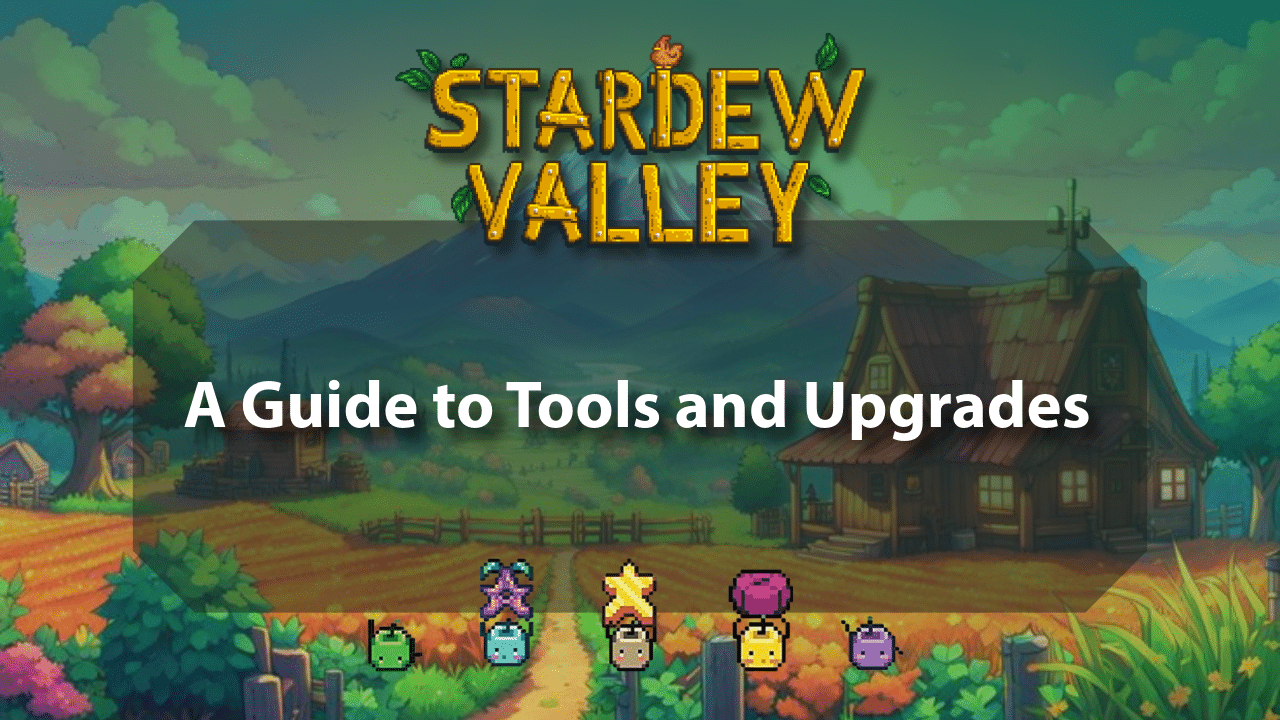Stardew Valley A Guide To Tools And Upgrades - Theria Games

Introduction to Stardew Valley A Guide to Tools and Upgrades
Upgrading tools in Stardew Valley is essential for improving efficiency and unlocking new capabilities that make daily farm work easier. Each tool starts at a basic level and can be upgraded at Clint’s Blacksmith shop in exchange for resources and gold. These upgrades reduce energy consumption, increase effectiveness, and sometimes grant access to new areas or features.
Planning the order of upgrades can have a significant impact on a player’s overall progression, allowing them to clear obstacles, tend to crops, and manage resources more effectively. Proper tool management ensures a smoother experience throughout the seasons, reducing time spent on repetitive tasks and freeing up time for other activities like foraging, fishing, and socializing with villagers. Stardew Valley: A Guide to Tools and Upgrades helps players make informed decisions about which tools to upgrade first and how to maximize their efficiency.
The most important tools to upgrade first depend on individual playstyles, but generally, the watering can and pickaxe are among the most impactful early on. A better watering can increases the number of crops that can be watered per use, reducing energy consumption and making large-scale farming more manageable. Meanwhile, upgrading the pickaxe allows players to break tougher rocks and clear the mines more efficiently, leading to faster access to valuable ores and minerals necessary for further upgrades. The axe is also a useful upgrade since stronger versions can break logs and stumps, unlocking new areas like the Secret Woods and providing access to hardwood, a critical resource for crafting and farm improvements.
The hoe and trash can upgrades are often lower priority but still provide benefits. An upgraded hoe allows for faster soil preparation, which is especially useful at the start of a new season when large fields need to be tilled quickly. The trash can, though sometimes overlooked, provides partial refunds when discarding items, helping players recover some lost funds. Choosing the right upgrade path based on seasonal needs and playstyle helps maximize productivity and ensures a steady progression in Stardew Valley. Investing in tool upgrades at the right time makes farm management smoother, allowing players to focus on other aspects of the game like exploration, relationships, and completing bundles in the Community Center.
Tool Upgrade Basics
The blacksmith, Clint, is responsible for all tool upgrades in Stardew Valley and can be found east of Pelican Town, just north of the Museum. Players can visit Clint’s shop to upgrade their tools by providing the required gold and metal bars. Once a tool is given for an upgrade, it will be unavailable for two days, meaning players must plan their upgrades carefully to avoid unnecessary setbacks in their daily farming routine. Despite tool upgrades taking time, Clint’s other services, such as breaking open geodes, remain available. When an upgrade is complete, a notification appears, and the upgraded tool can be collected from the Blacksmith.
Upgrades follow a structured progression, requiring metal bars in a specific order. The upgrade path consists of four levels: Copper, Iron, Gold, and Iridium. Each upgrade requires five bars of the respective metal, making ore collection and smelting essential for progression. The cost increases with each level, starting with 2,000g for Copper, 5,000g for Iron, 10,000g for Gold, and 25,000g for Iridium. The Trash Can is an exception, as its upgrades cost less than other tools. Since upgrades must be done in order, players cannot skip directly to higher levels, meaning a Copper tool must first be upgraded to Iron before it can become Gold.
Choosing when and what to upgrade is an important decision that depends on a player’s needs and playstyle. Tools such as the watering can and pickaxe are often prioritized early, as they directly impact farming efficiency and mining progression. The axe is also useful for clearing large debris and obtaining hardwood, while the hoe speeds up soil preparation, especially when planting crops in bulk at the start of a new season. Planning upgrades around the farming calendar and resource availability ensures smooth progression without unnecessary downtime. Proper tool management not only makes farm work easier but also frees up time for other activities like exploring, fishing, and building relationships with villagers.
Tool-Specific Upgrades and Uses
Each tool upgrade in Stardew Valley provides unique benefits, reducing energy consumption and improving efficiency. Some upgraded tools unlock new areas or features, making them essential for farm progression. Holding down the use tool button activates special abilities for certain tools, allowing players to work faster and more effectively. The Blacksmith, Clint, is responsible for upgrading tools using metal bars and gold, with each upgrade increasing a tool’s capabilities. Understanding the benefits of each tool upgrade helps players prioritize which tools to enhance first based on their farming needs and gameplay style.
The axe is primarily used for chopping trees and stumps to collect wood, an essential resource for crafting and building. Upgrading the axe reduces the number of hits needed to cut down trees, saving energy and time. The Copper Axe can break large stumps, while the Steel Axe can break large logs, granting access to the Secret Woods, where hardwood can be collected. The pickaxe is another vital tool, used to break rocks and ore veins in the mines.
Upgrading it improves mining efficiency, allowing players to break larger rocks and even meteorites. A Steel Pickaxe is required to break boulders on the farm and access the Dwarf in the mines. Higher-level pickaxes, such as the Iridium Pickaxe, can break most rocks in a single hit, making mining much faster and less energy-intensive.
The hoe is used for tilling soil to prepare for planting crops and can also be used to dig up artifact spots. Upgrading the hoe allows players to till multiple tiles at once, making large-scale farming more manageable. The Watering Can is essential for crop maintenance, and upgrading it increases water capacity while allowing more tiles to be watered at once. This is particularly useful in the early game before players gain access to sprinklers. The Fishing Rod, unlike other tools, is upgraded by purchasing better rods from Willy’s Fish Shop, allowing players to use bait and tackle to improve fishing success.
The Scythe, though it cannot be upgraded, plays an important role in harvesting grass and certain crops, with the Golden Scythe providing a larger cutting radius and a higher chance of obtaining hay. The Trash Can is the only tool that does not directly affect farming but can be upgraded to return a percentage of an item’s value when discarded. Other tools, such as the Backpack, Copper Pan, Milk Pail, and Auto-Grabber, provide additional farming benefits, increasing inventory space, allowing players to pan for ore, and automating the collection of animal products. Upgrading tools strategically helps players maximize productivity and progress efficiently throughout their farming journey.
Tool Enchantments
Tool enchantments provide an alternative way to enhance tools in Stardew Valley, offering unique benefits that improve efficiency and effectiveness. Enchantments are applied at the Forge on Ginger Island by using 20 Cinder Shards and one Prismatic Shard. Each tool can hold only one enchantment at a time, but upgrading a tool does not remove its existing enchantment. Since enchantments are assigned randomly, players may need to re-roll multiple times to obtain their preferred effect. These enhancements provide useful bonuses such as increased power, energy efficiency, or improved gathering rates, making them valuable for players looking to optimize their tool usage.
The axe, pickaxe, hoe, watering can, fishing rod, and even the Copper Pan can all be enchanted, each with different potential effects. The axe has enchantments that reduce stamina usage, increase chopping speed, or provide additional resources when cutting trees or breaking stumps. The pickaxe can be enchanted to use less stamina, work faster, or gain extra power for breaking rocks. The hoe has enchantments that increase its charging range, improve artifact discovery rates, or double collected items. The watering can can also receive enchantments that increase its watering range, prevent stamina drain, or grant unlimited water.
The fishing rod’s enchantments improve fishing efficiency, with effects such as automatically hooking fish, conserving bait and tackle, or granting a higher fishing level. Even the Copper Pan, which is primarily used for panning, can receive enchantments that increase artifact trove discovery rates, improve rewards, or even provide fish while panning.
Because enchantments are randomly assigned, players may need to spend additional resources at the Forge to get their desired effect. Some enchantments are particularly useful depending on the tool. For example, the Shaving enchantment for the axe provides extra wood and resources from trees and stumps, while the Preserving enchantment for the fishing rod helps conserve bait and tackle. The Generous enchantment for the hoe increases the chance of collecting double items when digging, making it useful for gathering clay and other materials.
The Powerful enchantment for the pickaxe increases its breaking strength, reducing the number of hits needed to mine rocks. The Efficient enchantment, which removes energy consumption, is universally beneficial for tools that require frequent use. Choosing the right enchantment for each tool can significantly improve farm management, making daily tasks easier and reducing the need for constant energy restoration.
Upgrade Order and Priorities
Upgrading tools in Stardew Valley is essential for improving farming efficiency, saving energy, and unlocking new areas. Prioritizing upgrades strategically allows players to maximize productivity while progressing through the game. While all tools eventually need to be upgraded, some provide more immediate benefits than others. The pickaxe is one of the most valuable tools to upgrade early because it directly affects mining speed, which is crucial for gathering ores and resources needed for further upgrades. A Steel Pickaxe also allows players to break large boulders on the farm and clear obstacles in the mines, making deeper exploration faster and easier.
The axe is another high-priority upgrade because it allows players to collect wood more efficiently, which is necessary for crafting buildings, fences, and other essential farm structures. A Copper Axe can break large stumps, while a Steel Axe grants access to the Secret Woods, an important source of hardwood. The watering can is also a key tool to upgrade, especially for players managing large crop fields without immediate access to sprinklers.
Upgrading it reduces the number of refills needed and allows players to water multiple tiles at once, saving time and energy. The hoe, while not as essential as other tools early on, becomes more useful as farm expansion continues, as upgrades allow players to till multiple tiles at once, speeding up the planting process.
Tool upgrade priorities can vary based on specific playstyles and farm layouts. For players focusing on mining, upgrading the pickaxe as soon as possible is the best choice, while those on the Beach Farm, where sprinklers are less effective, may prioritize the watering can instead. The Steel Axe is particularly important for players aiming to complete the Community Center in the first year, as it grants access to fiddlehead ferns in the Secret Woods.
The Trash Can, while useful for reclaiming a portion of the value of discarded items, is generally the lowest priority and should only be upgraded once more essential tools have been improved. By carefully choosing which tools to upgrade and when, players can optimize their farm operations, making daily tasks easier and more efficient.
Tips and Strategies
Upgrading tools in Stardew Valley requires careful planning to maximize efficiency while minimizing downtime. Since tool upgrades take two days to complete, timing is essential to avoid disruptions in daily farm tasks. A well-planned upgrade for the watering can is best done before a rainy day, allowing crops to be watered automatically while the upgrade is in progress. Similarly, tools that are not used daily, such as the axe or hoe, can be upgraded during periods when they are less critical. If a festival is approaching, consider giving Clint a tool for an upgrade beforehand, as he will still complete the upgrade on schedule despite not being available for regular services on festival days.
The order in which tools are upgraded should align with the player’s goals and playstyle. Those focusing on mining should prioritize the pickaxe to clear rocks faster and reach deeper levels of the mines. Farmers who rely on crops should upgrade the watering can and hoe to speed up planting and watering processes.
Sprinklers can reduce the need for watering can upgrades, but in farms with limited sprinkler placement options, such as the Beach Farm, upgrading the watering can remains essential. The axe is a crucial upgrade for players looking to unlock the Secret Woods early for hardwood, which is needed for farm buildings and crafting. The trash can, while often overlooked, allows players to recover a percentage of the value of discarded items, making it a useful long-term investment.
Beyond upgrades, enchantments provide additional enhancements to tools through the Forge on Ginger Island. These enchantments are randomized, but reloading the day or enchanting a different tool can change the outcome. Some enchantments, such as Efficient, which removes energy consumption, or Powerful, which increases tool effectiveness, can greatly improve productivity. Players should also be mindful of certain tool limitations, such as the Golden Scythe, which cannot be replaced if lost. Managing inventory wisely is crucial, especially when mining, where carrying essential tools and enough food for healing can make a significant difference. Strategic upgrades and enchantments, combined with proper planning and efficient resource management, help create a smoother farming and exploration experience.
Conclusion
Upgrading tools is a crucial aspect of improving efficiency and productivity in Stardew Valley. Carefully planning upgrades allows players to reduce energy consumption, increase farming and mining speed, and unlock new areas. Prioritizing upgrades based on individual playstyle can make a significant difference, whether focusing on expanding crop production, delving deeper into the mines, or gathering essential resources. Tools such as the pickaxe and axe are particularly important early on, as they allow access to valuable materials and new locations. The watering can upgrade is beneficial for those relying on manual crop irrigation, though sprinklers can serve as an alternative to reduce daily watering tasks.
Timing tool upgrades properly ensures that progress is not hindered. Since tool upgrades take two days, planning around rainy days or festival schedules can help avoid disruptions to daily farm work. Choosing the right time to upgrade the hoe or watering can is particularly important to prevent delays in planting or watering crops. The trash can, while often overlooked, provides an additional way to recover some value from discarded items. Additionally, tool enchantments available at the Forge on Ginger Island offer further improvements, enhancing tool effectiveness and reducing energy consumption. Enchantments can be randomized and re-rolled, allowing players to tailor their tools to suit their specific needs.
Ultimately, the best tool upgrade strategy depends on the player’s goals and preferred activities. A well-planned upgrade path helps streamline farm management, making daily tasks more efficient and freeing up time for other activities such as fishing, foraging, or completing quests. Whether focusing on crop production, mining, or exploring new areas, upgrading and enchanting tools is essential for long-term success in Stardew Valley. By considering energy efficiency, timing, and personal priorities, players can optimize their tools to support their unique approach to life in the valley.













